Installing a green roof for natural home cooling is a smart, eco-friendly choice. You'll benefit from reduced energy costs as the vegetation acts as natural insulation, lowering your home's temperature. Green roofs also improve air quality, manage stormwater runoff, and extend your roof's lifespan. They create a beautiful, living space that enhances biodiversity and property value. While initial costs may seem high, the long-term savings on energy bills and environmental benefits make it a worthwhile investment. You'll need to evaluate structural requirements, plant selection, and local regulations before installation. Exploring this sustainable solution further could uncover even more advantages for your home and the planet.
Understanding Green Roof Technology

With the growing interest in sustainable architecture, green roof technology has emerged as an innovative solution for natural home cooling. A green roof, also known as a living roof, is a layer of vegetation planted over a waterproofing system installed on top of a flat or slightly sloped roof.
This system typically consists of several layers, including a root barrier, drainage layer, growing medium, and plants.
You'll find two main types of green roofs: extensive and intensive. Extensive green roofs are lightweight, low-maintenance systems with a thin layer of soil and drought-resistant plants like sedums. Intensive green roofs, on the other hand, have a deeper soil layer and can support a wider variety of plants, including shrubs and small trees.
Green roofs work by providing natural insulation and shading to your home. The vegetation absorbs solar radiation and reduces heat transfer through the roof. Additionally, the plants' evapotranspiration process cools the surrounding air.
This natural cooling effect can considerably reduce your home's energy consumption for air conditioning, especially during hot summer months. By understanding green roof technology, you can make an informed decision about implementing this eco-friendly solution for your home.
Benefits of Natural Home Cooling
Natural home cooling offers three key benefits that make it an attractive option for homeowners.
First, you'll save money on energy bills. By reducing your reliance on air conditioning, you'll see a significant decrease in electricity consumption during hot summer months. This translates to lower utility costs and more money in your pocket.
Second, you'll enjoy improved indoor air quality. Unlike air conditioning systems that recirculate the same stale air, natural cooling methods promote better ventilation. This means you'll breathe fresher, cleaner air, which can help reduce allergies and respiratory issues.
Lastly, you'll decrease your carbon footprint. Natural cooling techniques don't rely on energy-intensive mechanical systems, which means you'll reduce your greenhouse gas emissions. This environmentally friendly approach helps combat climate change and supports sustainability efforts.
Selecting Suitable Plants

When choosing plants for your green roof, you'll need to take into account your local climate and select vegetation that thrives in those conditions.
Opt for drought-resistant species to minimize maintenance and guarantee your roof's longevity.
Additionally, pay attention to the root systems of your chosen plants, as shallow-rooted varieties are typically better suited for green roof applications.
Climate-Appropriate Vegetation Choices
Success in green roof implementation hinges on selecting the right plants for your climate.
You'll need to take into account your local weather patterns, including temperature extremes, rainfall, and sunlight exposure. For hot, dry climates, opt for drought-resistant succulents like sedum or echeveria. These plants store water in their leaves and can withstand long periods without rain.
In more temperate regions, you've got a wider range of options. Think about native grasses, wildflowers, and hardy perennials that can adapt to your specific conditions.
Plants like coneflowers, black-eyed susans, and ornamental grasses often thrive on green roofs in these areas.
For cooler, wetter climates, choose plants that can handle excess moisture and lower temperatures.
Mosses, ferns, and alpine plants are excellent choices. They'll absorb rainwater effectively and withstand colder conditions.
Don't forget to factor in the depth of your green roof's growing medium.
Shallow substrates suit low-growing plants like sedums, while deeper layers can support a more diverse range of vegetation.
Drought-Resistant Plant Options
Building on the concept of climate-appropriate vegetation, let's focus on drought-resistant plants for green roofs. These hardy species are ideal for regions with limited rainfall or water restrictions, guaranteeing your green roof remains lush and functional with minimal maintenance.
Consider succulents like sedum, which come in various colors and textures. They store water in their leaves and thrive in sunny, dry conditions. Sempervivum, or hens and chicks, is another excellent choice, forming attractive rosettes that spread easily.
For a more diverse look, add drought-tolerant grasses like blue fescue or Mexican feather grass.
Don't overlook native wildflowers adapted to your local climate. They'll attract pollinators and add vibrant colors to your roof. Options might include coneflowers, black-eyed susans, or blanket flowers, depending on your region.
For a more structured appearance, consider drought-resistant shrubs like lavender or rosemary. These aromatic plants not only look great but also offer culinary benefits.
Remember to group plants with similar water needs together and guarantee proper drainage to prevent waterlogging.
Root System Considerations
Root systems play an essential role in selecting plants for your green roof. You'll need to choose species with shallow, fibrous roots that won't damage your roof's structure. These types of roots spread horizontally rather than growing deep, which is ideal for the limited soil depth on most green roofs.
Look for plants with roots that can efficiently absorb water and nutrients from a thin layer of growing medium. Sedums and succulents are excellent choices, as their roots are typically shallow and spread out, allowing them to thrive in minimal soil. Native grasses and wildflowers can also work well, but be sure to research their root characteristics before planting.
Avoid plants with aggressive or invasive root systems, as these can compromise your roof's waterproofing membrane. Trees and large shrubs are generally unsuitable due to their deep, extensive root systems.
When planning your green roof, consider the mature size of each plant and its root spread to guarantee proper spacing. This will prevent overcrowding and competition for resources, which can stress the plants and potentially damage your roof structure.
Structural Considerations for Installation
When contemplating a green roof installation, structural integrity is paramount. You'll need to verify your existing roof can support the additional weight of soil, plants, and water. Consult a structural engineer to assess your roof's capacity and recommend any necessary reinforcements.
Evaluate these key factors for your green roof installation:
| Factor | Importance | Considerations |
|---|---|---|
| Load-bearing capacity | High | Soil weight, plant weight, water retention |
| Roof slope | Medium | Drainage, erosion control, plant selection |
| Waterproofing | High | Membrane quality, root barriers, leak detection |
You'll need to choose between extensive (lightweight, low-maintenance) or intensive (heavier, more diverse plantings) green roof systems. Extensive systems typically add 10-25 pounds per square foot, while intensive systems can add 80-150 pounds per square foot.
Don't forget to factor in access for maintenance and the potential need for irrigation systems. You'll also want to evaluate the climate in your area and how it might affect your green roof's performance and longevity. By carefully addressing these structural considerations, you'll guarantee a successful and sustainable green roof installation that provides natural cooling benefits for years to come.
Waterproofing and Drainage Systems

A robust waterproofing and drainage system forms the backbone of any successful green roof installation.
You'll need to guarantee your roof is completely watertight before adding any green elements. Start by applying a high-quality waterproof membrane over your existing roof structure. This barrier prevents water from seeping into your home and protects against root penetration.
Next, install a drainage layer to manage excess water. This layer typically consists of a perforated plastic sheet or gravel bed that allows water to flow freely to designated drainage points.
On top of this, you'll place a filter fabric to prevent soil particles from clogging the drainage system.
Don't forget to incorporate irrigation systems if your climate requires supplemental watering. You can use drip irrigation or sprinklers, depending on your roof's size and plant selection.
Guarantee you've planned for easy access to these systems for maintenance.
Soil Mixture and Depth
With your waterproofing and drainage systems in place, it's time to focus on the growing medium for your green roof. The soil mixture you choose is vital for plant health and roof performance. Opt for a lightweight, well-draining blend specifically designed for green roofs. This typically includes a mix of inorganic materials like expanded slate, shale, or clay, combined with organic matter and compost.
The soil depth depends on the type of green roof you're installing. Extensive green roofs, which are lighter and require less maintenance, typically have a soil depth of 3-6 inches. This depth supports shallow-rooted plants like sedums and herbs.
Intensive green roofs, which can accommodate larger plants and even trees, need a soil depth of 6-12 inches or more.
Consider your local climate when determining soil depth. In hotter, drier regions, you'll want a deeper soil layer to retain moisture and protect plant roots. In cooler, wetter climates, a shallower depth may suffice.
Green Roof Maintenance Requirements
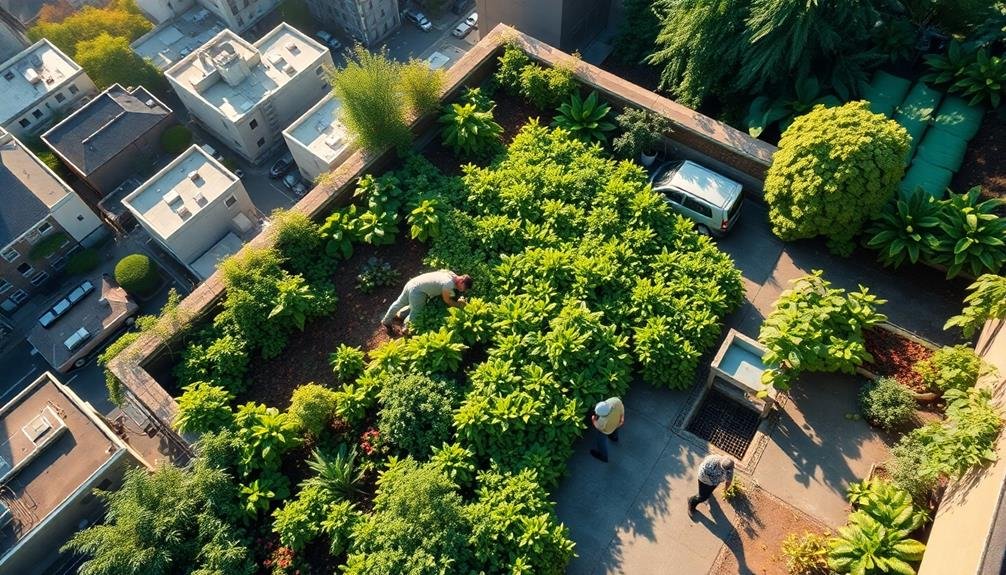
Regular maintenance is vital for the longevity and effectiveness of your green roof. You'll need to perform routine checks and care to guarantee your green roof continues to provide maximum cooling benefits for your home.
Start by inspecting the roof at least twice a year, preferably in spring and fall, to address any issues promptly.
During these inspections, you should:
- Remove any debris or unwanted plants
- Check for signs of erosion or bare spots
- Assess the overall health of the vegetation
- Inspect drainage systems for blockages
- Test the waterproofing membrane for leaks
You'll need to water your green roof during dry spells, especially in the first year as plants establish themselves.
Fertilize sparingly, using slow-release organic options to avoid nutrient runoff. Trim plants as needed to maintain desired aesthetics and prevent overgrowth.
If you notice any structural issues or water damage, consult a professional immediately.
Cost Analysis and ROI
Dollars and cents often drive home improvement decisions, and green roofs are no exception. While the initial installation costs can be higher than traditional roofing, you'll find that the long-term benefits often outweigh the upfront expenses. Green roofs typically cost between $10 to $25 per square foot, depending on the type and complexity of the system.
To understand the potential return on investment (ROI), consider these factors:
| Factor | Benefit | Estimated Savings |
|---|---|---|
| Energy Savings | Reduced cooling costs | 15-25% annually |
| Roof Longevity | Extended roof lifespan | 2-3 times longer |
| Property Value | Increased home value | 3-7% on average |
You'll see immediate savings on your energy bills, as the green roof acts as natural insulation. Over time, you'll also save on roof replacement costs, as green roofs can last up to 40 years compared to 20 years for traditional roofs. Additionally, the added aesthetic appeal and environmental benefits can increase your property value, making it a wise investment for the future.
Energy Savings Potential
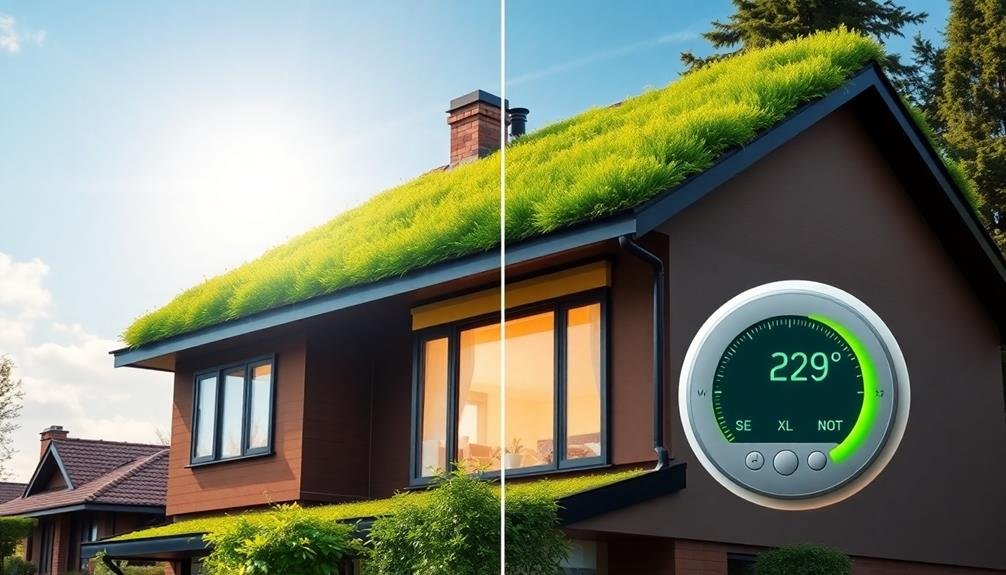
Boasting impressive thermal properties, green roofs offer substantial energy savings potential for homeowners. You'll experience a significant reduction in your cooling costs during hot summer months, as the vegetative layer acts as a natural insulator. This green barrier prevents heat from penetrating your home's interior, reducing the need for air conditioning.
In winter, your green roof will help retain heat, lowering your heating expenses. The energy-saving benefits extend beyond just temperature regulation.
You'll notice:
- Reduced urban heat island effect
- Improved air quality
- Extended roof lifespan
- Lower stormwater runoff
- Enhanced biodiversity
These factors contribute to overall energy efficiency and sustainability. By installing a green roof, you're not only cutting your energy bills but also reducing your carbon footprint. The plants absorb CO2 and release oxygen, further improving your home's environmental impact.
You'll find that the energy savings potential of a green roof increases with the size of your roof and the climate in your area. In hot, sunny regions, you can expect even greater benefits as the roof's cooling effect becomes more pronounced.
Environmental Impact and Sustainability
One of the most compelling reasons to install a green roof is its positive environmental impact and sustainability benefits. When you opt for a green roof, you're actively contributing to improved air quality in your local area. The plants on your roof absorb carbon dioxide and release oxygen, helping to reduce greenhouse gas emissions.
They also filter airborne pollutants and dust particles, creating a healthier environment for you and your neighbors.
Green roofs play an essential role in managing stormwater runoff. They can retain up to 90% of rainfall, reducing the strain on urban drainage systems and helping to prevent flooding.
This natural water management system also filters pollutants from rainwater, improving the quality of water that eventually reaches local water bodies.
Local Regulations and Permits

Before installing a green roof, you'll need to check your local regulations and obtain necessary permits.
Requirements can vary greatly between cities and even neighborhoods, so it's essential to research your specific area's rules.
You may find that some localities have zoning laws specifically addressing green roofs, while others might require special approvals or structural assessments.
Permit Requirements Vary Locally
Local regulations and permits for green roofs can differ markedly from one area to another. You'll need to check with your local building department to determine the specific requirements for your area. Some cities actively encourage green roofs and have streamlined the permit process, while others may have more stringent regulations.
When researching permit requirements, you'll likely encounter variations in:
- Structural load capacity assessments
- Waterproofing and drainage specifications
- Fire safety measures
- Plant selection and maintenance plans
- Environmental impact studies
It's essential to understand that obtaining the necessary permits isn't just a bureaucratic hurdle; it's a step to guarantee your green roof is safe, effective, and compliant with local standards.
You might need to work with an architect or structural engineer to provide detailed plans and calculations. Some areas may require periodic inspections or ongoing maintenance reports.
Don't be discouraged if the process seems complex. Many local authorities offer guidance and resources to help you navigate the permit requirements.
Green Roof Zoning Laws
Zoning laws frequently play an important role in determining whether you can install a green roof on your property. These regulations can vary considerably between municipalities, so it's vital to research your local zoning codes before starting your project. You'll need to take into account factors such as building height restrictions, structural load capacity, and potential impacts on neighboring properties.
Some cities have embraced green roofs and offer incentives for their installation, while others may have more restrictive policies. Here's a quick overview of common zoning considerations:
| Zoning Factor | Potential Requirements | Impact on Green Roof Installation |
|---|---|---|
| Building Height | Maximum height limits | May affect roof access and vegetation depth |
| Structural Load | Load-bearing capacity | Determines feasible green roof type |
| Drainage | Stormwater management | Influences design and runoff control |
It's important to work with local authorities and possibly consult a zoning expert to guarantee your green roof project complies with all applicable regulations. You may need to submit detailed plans, obtain special permits, or even seek variances if your proposed green roof doesn't align with existing zoning laws. By understanding and adhering to these regulations, you'll be better positioned to successfully implement your natural home cooling solution.
DIY Vs Professional Installation
When it comes to installing a green roof, you'll need to weigh the pros and cons of DIY versus professional installation.
DIY can save you money and give you a sense of accomplishment, but it requires extensive research, planning, and physical labor.
Professional installation guarantees expert knowledge and proper execution but comes at a higher cost.
If you're considering DIY, make certain you:
- Have a solid understanding of structural requirements
- Can source appropriate materials and plants
- Are comfortable working at heights
- Possess the necessary tools and equipment
- Can dedicate significant time to the project
Professional installation offers peace of mind and typically includes warranties.
Experts can navigate complex regulations, guarantee proper waterproofing, and select the best plants for your climate.
They'll also handle logistics like crane rentals for material transport.
Ultimately, your decision depends on your skill level, budget, and the complexity of your green roof project.
If you're tackling a small, simple installation and have construction experience, DIY might be feasible.
For larger or more complex projects, professional installation is often the safer and more efficient choice.
Additional Green Roof Features

Green roofs offer more than just plant life and insulation. They can incorporate a variety of features to enhance their functionality and aesthetic appeal. You'll find that these additional elements can transform your green roof into a multi-purpose space that serves both environmental and practical needs.
Consider integrating some of these features into your green roof design:
| Feature | Benefits |
|---|---|
| Rainwater harvesting | Reduces runoff, conserves water |
| Solar panels | Generates clean energy, offsets costs |
| Seating areas | Creates usable outdoor space |
| Walkways | Improves accessibility, defines spaces |
| Lighting | Extends usability into evening hours |
Frequently Asked Questions
Can a Green Roof Attract Pests or Wildlife to My Home?
Yes, a green roof can attract some wildlife and insects. You'll likely see birds, butterflies, and beneficial bugs. However, proper design and maintenance can minimize pest issues. It's important to choose appropriate plants and monitor regularly.
How Does a Green Roof Affect Property Value and Resale Potential?
You'll likely see increased property value and resale potential with a green roof. It's an eco-friendly feature that attracts buyers, improves energy efficiency, and stands out in the market. Plus, it can extend your roof's lifespan.
Are There Any Fire Safety Concerns Associated With Green Roofs?
You'll need to take into account fire safety with green roofs. While they can be designed to resist fire, improper maintenance or dry vegetation can increase risks. Make certain you follow local building codes and use fire-resistant plants and materials.
Can I Use My Green Roof as an Accessible Garden Space?
You can definitely use your green roof as an accessible garden space! It's a great way to maximize your outdoor area. Just confirm it's designed to support foot traffic and has proper safety features like railings in place.
How Do Green Roofs Perform in Extreme Weather Conditions Like Hailstorms?
Green roofs generally perform well in extreme weather. They'll protect your roof from hail damage, absorbing the impact. You'll find they also insulate against extreme temperatures and heavy rain, reducing runoff and extending your roof's lifespan.
In Summary
You've learned about the many benefits of green roofs for natural home cooling. From selecting plants to understanding structural requirements, you're now equipped to make an informed decision. Whether you choose DIY or professional installation, remember to take into account local regulations and permits. By installing a green roof, you'll not only cool your home naturally but also contribute to environmental sustainability. It's a smart investment for your comfort and the planet's future.
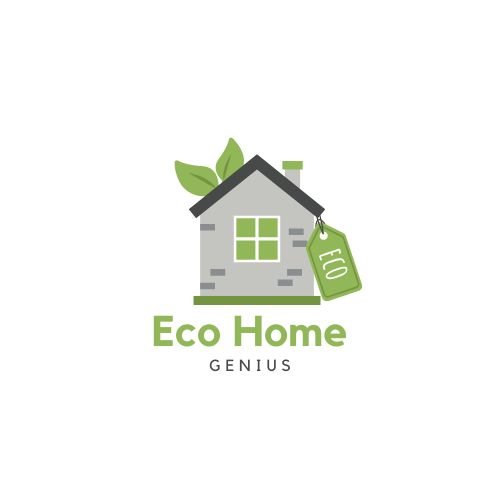

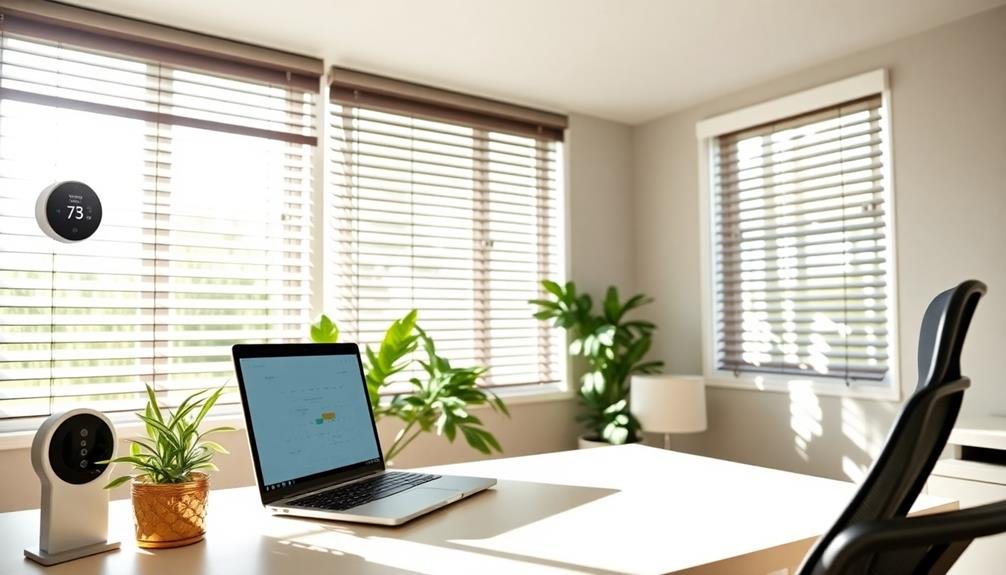
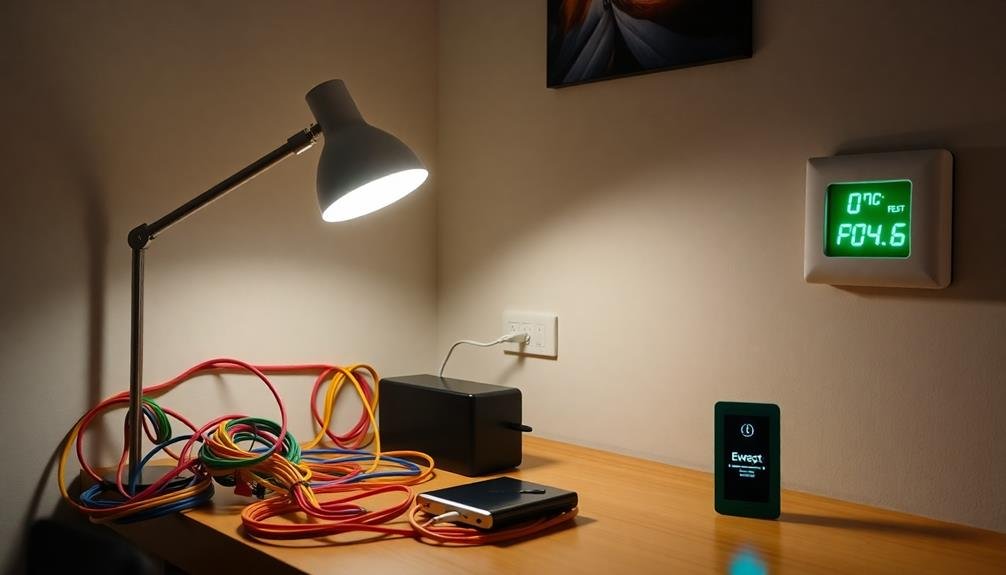
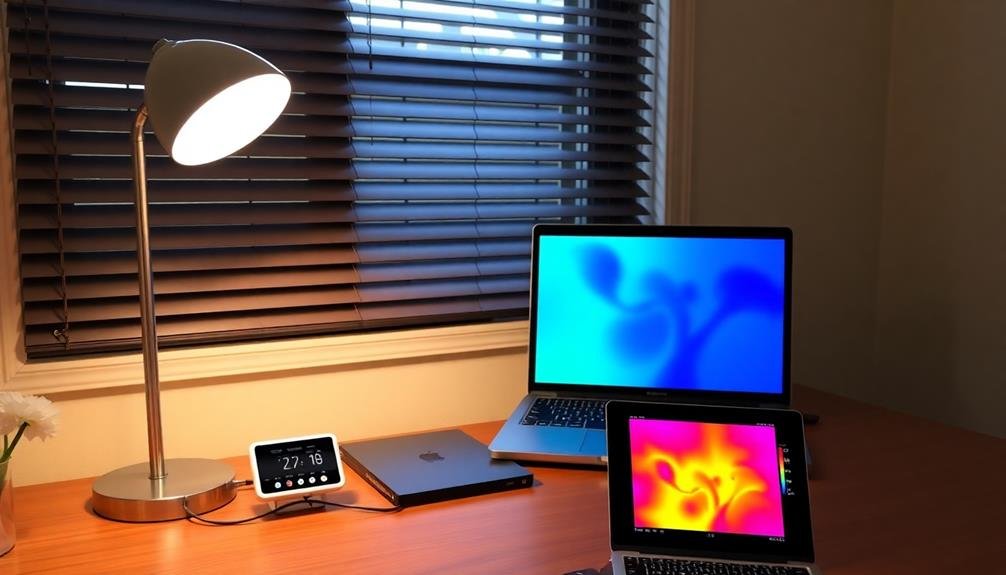
Leave a Reply